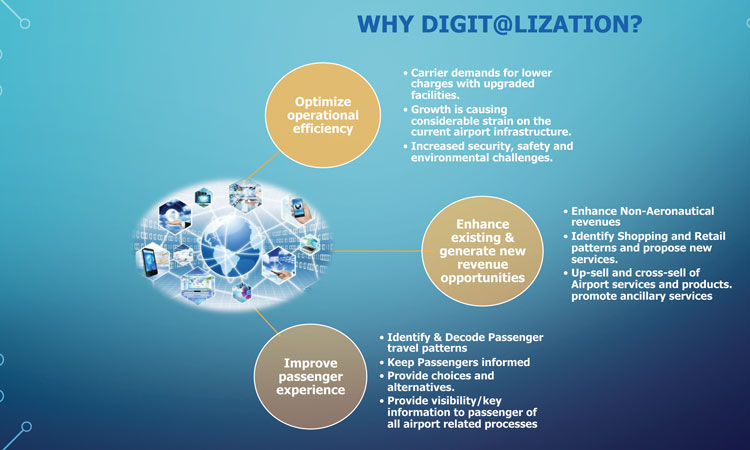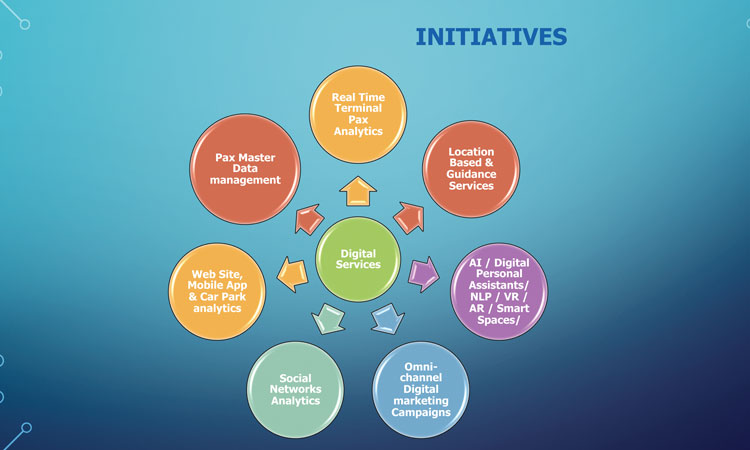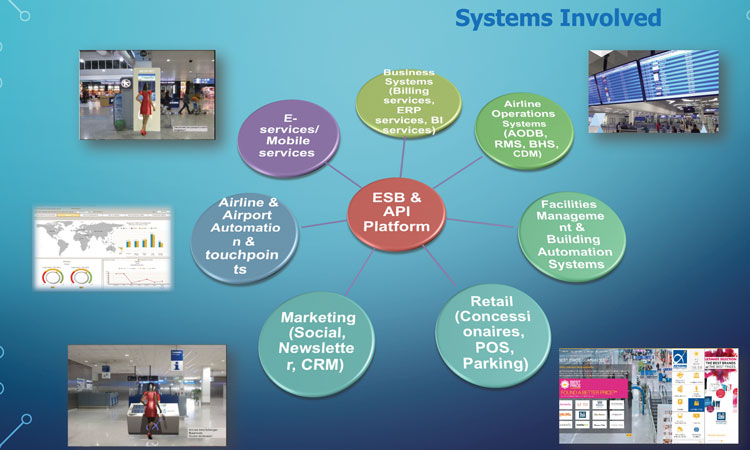Airport digital transformation: Laying the foundations
- Like
- Digg
- Del
- Tumblr
- VKontakte
- Buffer
- Love This
- Odnoklassniki
- Meneame
- Blogger
- Amazon
- Yahoo Mail
- Gmail
- AOL
- Newsvine
- HackerNews
- Evernote
- MySpace
- Mail.ru
- Viadeo
- Line
- Comments
- Yummly
- SMS
- Viber
- Telegram
- Subscribe
- Skype
- Facebook Messenger
- Kakao
- LiveJournal
- Yammer
- Edgar
- Fintel
- Mix
- Instapaper
- Copy Link
Posted: 19 January 2017 | Nikolaos Papagiannopoulos | No comments yet
As the world economy is entering the fourth industrial revolution, which signals a major shift from the service economy to the experience economy, airports realise the need to transform their role from simple enablers of air travel to participators in the travel process and active promoters in its inception, planning and execution. Nikolaos Papagiannopoulos, Project Leader of Database Architecture at Athens International Airport, outlines how airports can implement an IT architecture that allows for the seamless integration of content from different systems, regardless of the technology employed but without altering the source systems.


The continuous increase of passenger traffic over recent years and the competition between the full service and low cost carriers have emphasised capacity and infrastructure strains, and resulted in the increasing use of alternative to the central, secondary airports. Coupled by the shift of the airport revenue structure from aeronautical to commercial and passenger services revenues (non-aeronautical revenues), airports seek to introduce new services and procedures that will contribute to operational efficiency, to enhance existing and create new revenue streams, but, most importantly, to increase passenger satisfaction. This in turn generates opportunities for digitalisation as, shown in Figure 1.


Figure 1: The three axes of airport digitisation
Increased passenger satisfaction is strongly coupled with increased spending of passengers at airports1, while at the same time is one of the criteria that transit passengers, and those who have a choice of more than one local airport to choose from for their travel, take into consideration during the planning of their trips.
In this context, new portfolios of innovative and disruptive services and new practices, such as data analytics, omni-channel personalised marketing campaigns, cloud and social media-based services, real-time content delivery services, integration of third party information (e.g. weather, traffic information), location based and way finding services are some of the few initiatives that many airports embrace and schedule for implementation within the immediate future.
Airport digital services can be seen in Figure 2.


Figure 2: Airport digital services
Equally important are synergies between the stakeholders that participate in every aspect of the passenger journey from home, to and from airport, including the air travel. The holistic approach of servicing the passenger throughout the journey or even before, during the planning and decision making phase of the trip, is of utmost importance, and the most complex phase to address for achieving passenger satisfaction. This requires the fusion of information flows from airlines, travel agencies, airports, ground handlers, concessionaires, rail, metro and highway operators, air traffic management, etc.
The accurate, efficient and timely integration of this information can provide the passenger with visibility throughout the travel processes so as to complete their trip. The immediate consequence of having visibility is the elimination of stress, since the risk of unforeseen events is significantly diminished, resulting to increased passenger satisfaction.
Challenges to be addressed
The development of new portfolios of innovative and disruptive services and interfacing with stakeholders requires resilient platforms orchestrating the information flows from the different sources to the appropriate targets, the integration and the distribution of the content and the resulting services to the intended users. The effortless and timely introduction of these services into operations and the integration of the information flows – in most of the cases in real-time – is the main driver for an airport to achieve the three axes of digitalisation.
Airports, due to the nature of their operations, have been at the forefront of technology through the last four decades, by implementing specialised software to allow for the coordination with airlines at an international level. Airports operate many IT systems that have been developed on different platforms, using different technologies, standards and protocols over an extended period.
It is not uncommon for airports to utilise more than 200 different software applications for supporting the many areas of airport operations. In most cases these applications are tailor made and have a proprietary design to support mission critical and, sometimes, life critical services (i.e. aeronautical aids).
This technology landscape has been the prevailing one and has proven resilient and trustworthy enough to ensure the safe and efficient delivery of airport’s core activities.
Additionally, over the years, a lot of point-to-point connections have been established to cover various business needs, making the infrastructure hard and costly to maintain, expand and be adapted to any new business needs. Furthermore, system changes or upgrades that may occur will require extra effort so that they maintain and inherit the existing point-to-point connections.
It is this technology landscape, though, that in many cases hinders the efforts for the implementation of digital services and the integration with third parties’ systems. In this respect, these proprietary systems are difficult to interface with, since they are connected to other systems directly, and it is very difficult and/or risky to alter them. One of the ways to address this issue is the implementation of an IT architecture that allows for the seamless integration of content from different systems, regardless of the technology employed but without altering the source systems.
The integration should be transparent, but at the same time secure and safe to allow the airport stakeholders to send and request information.
Way forward
The implementation of a Service Oriented Architecture (SOA) is the best strategy to bring system and services architectural agility to an enterprise. Furthermore, for building and exposing services, SOA has the ability to leverage these services over and over again within applications (known as composite applications). SOA also provides the required governance and orchestration of these services, or individually leverages these services. SOA’s main advantage is that it is usually applied to existing and established IT ecosystems. In this way, the existing investment in infrastructure is protected, while at the same time the airports achieve the required technological agility to embrace business opportunities as effortlessly and timely as possible.
SOA architecture allows for the interaction of loosely coupled services that operate independently. It also allows for service reuse, making it unnecessary to start from scratch when upgrades and other modifications are needed. This is a benefit to businesses that seek ways to save time and money.
Case study: Athens International Airport
Athens International Airport (AIA) has made the strategic decision to embrace the digital era, and AIA’s IT&T department has already initiated several projects to adopt a service-oriented architecture. AIA invests in a platform that supports a flexible, secure, scalable and cost effective solution to manage information flow among systems.
The Enterprise Service Bus (ESB) and Application Programming Interface (API) Management Platform are the industry proven standards for a successful SOA implementation.
The ESB platform
The ESB platform utilises specialised software connectors to connect to proprietary and legacy systems, plus accessing the content and exporting it as a web service for effortless and simplified interfacing with other systems. In this way, any risk of altering the original systems is alleviated, while at the same time the content is made available for exploitation.
AIA will adopt a service-oriented model to:
- Efficiently provide and reuse information flows from its systems
- Have the flexibility to adopt new services
- Provide the highest standards in safety and security
- Provide a stable environment preventing delays and downtimes
- Have strong governance monitoring and control of interfaces and information flows.
The ESB functionality with the SOA model will provide a stable, secure and strong base for AIA to build the required service model that will:
- Act as a central point of reference for interface exchange, in order to avoid multiple point-to-point connections between systems
- Efficiently support and manage new business needs
- Enable data and protocol transformation between data providers and consumers giving the ability to choose a standard format that can be efficiently supported with low cost
- Have low impact to existing business operations
- Enable reliable, asynchronous messaging to build highly available and fault tolerant applications
- Control and monitor traffic of resources provided to external parties
- Apply standard and consistent authentication, security and monitoring policies across applications
- Improve auditing of data flows and also monitoring and tracking of the service level agreements (SLA).
The API platform
Further to transforming the internal point-to-point interconnections to SOA interconnections, AIA will provide specific sets of services to its external customers through APIs. In order to achieve this, an API Management Platform must be provided and configured in order to streamline the process of publishing, promoting and overseeing application programming interfaces in a secure, scalable environment.
The API management platform will:
- Automate and control connections between the API and the application(s) that use it
- Protect the API from misuse by wrapping it in security procedures and policies
- Ensure consistency between multiple API implementations and versions
- Monitor traffic from individual apps
- Provide Single Sign On (SSO) capabilities
- Provide memorymanagement and caching mechanisms to improve application performance
- Provide analytics and detailed reports for the usage of each API
- Monetise the use of interfaces and content from external parties.
The introduction of a new SOA architecture at AIA is a three-year-long journey, based on the project phasing. In Year 1 we performed the business analysis which included the recording of the interfaces, the point-to-point connections, the required information flows, the assessment of existing applications and the applicability of replacing them with composite services and the sizing of both platforms.
As per project plan, in Year 2 (current phase), the implementation of the platform and the creation of the critical and business important interfaces have been initiated. In Year 3 most of the IT landscape will use the ESB and API platforms to exchange information between systems, while at the same time the replacement of existing applications with composite services will take place.
The ESB and API platforms (Figure 3) will play a significant role in the implementation of two major AIA projects, one that is related to advanced analytics and another which is related to the provisioning of IT&T services offered to the airport community (airlines, handlers, passengers, concessionaires, authorities, etc.).


Figure 3: Typical airport interfaces and connections of ESB and API platforms
More specifically, AIA wants to collect anonymous passenger data from all airport systems in order to create client profiles and use them for marketing purposes. This will enable the ESB platform to be responsible for collecting all the necessary data from airport systems for the creation of customer profiles and expose the customised promotions to the selected passengers.
In conclusion, airports have to address the challenge of improving their services by providing new functionalities due to customer requests, marketplace needs and rapidly changing technologies. Over the last three years AIA has experienced tremendous growth in passenger traffic numbers, with 2016 surpassing the spectacular record of 2015 (18.1 million passengers), over 12.5 million in 2013. Therefore, AIA has made a strategic choice to embark to a digital transformation initiative, to achieve enhanced customer satisfaction, operational efficiency and enhanced commercial services. The implementation of a SOA for the airport with the use of ESB and API platforms will provide the technological landscape and enable the rapid implementation of new digital services to support the required business agility.
Reference
- Passenger satisfaction the key to growing non-aeronautical revenue: http://www.dkma.com/en/images/downloads/commercial/Passenger%20satisfaction%20-%20the%20key%20to%20growing%20non-aeronautical%20revenue.pdf
Biography
Nikolaos Papagiannopoulos is Project Leader of Database Architecture at Athens International Airport. Nikolaos has more than 17 years of professional experience working in the IT department at Athens International Airport. He is an expert in airport IT solutions and a consultant and implementer of many large-scale information management projects both locally and internationally. He also has considerable experience in airport and airline operations and business requirements both from an operational and a commercial standpoint. He is a leader of validation work packages of aircraft turnaround EU FP7 related funded research projects. He is an expert in data management and database architecture and is currently working on the airport’s Service Oriented Architecture transformation initiative. Nikolaos is a PMP, CISA, CRISC, CISSP, ITIL Certified, MSc and MBA holder.
Issue
Related topics
Communication Technology, Digital transformation, Information technology (IT), New technologies


















